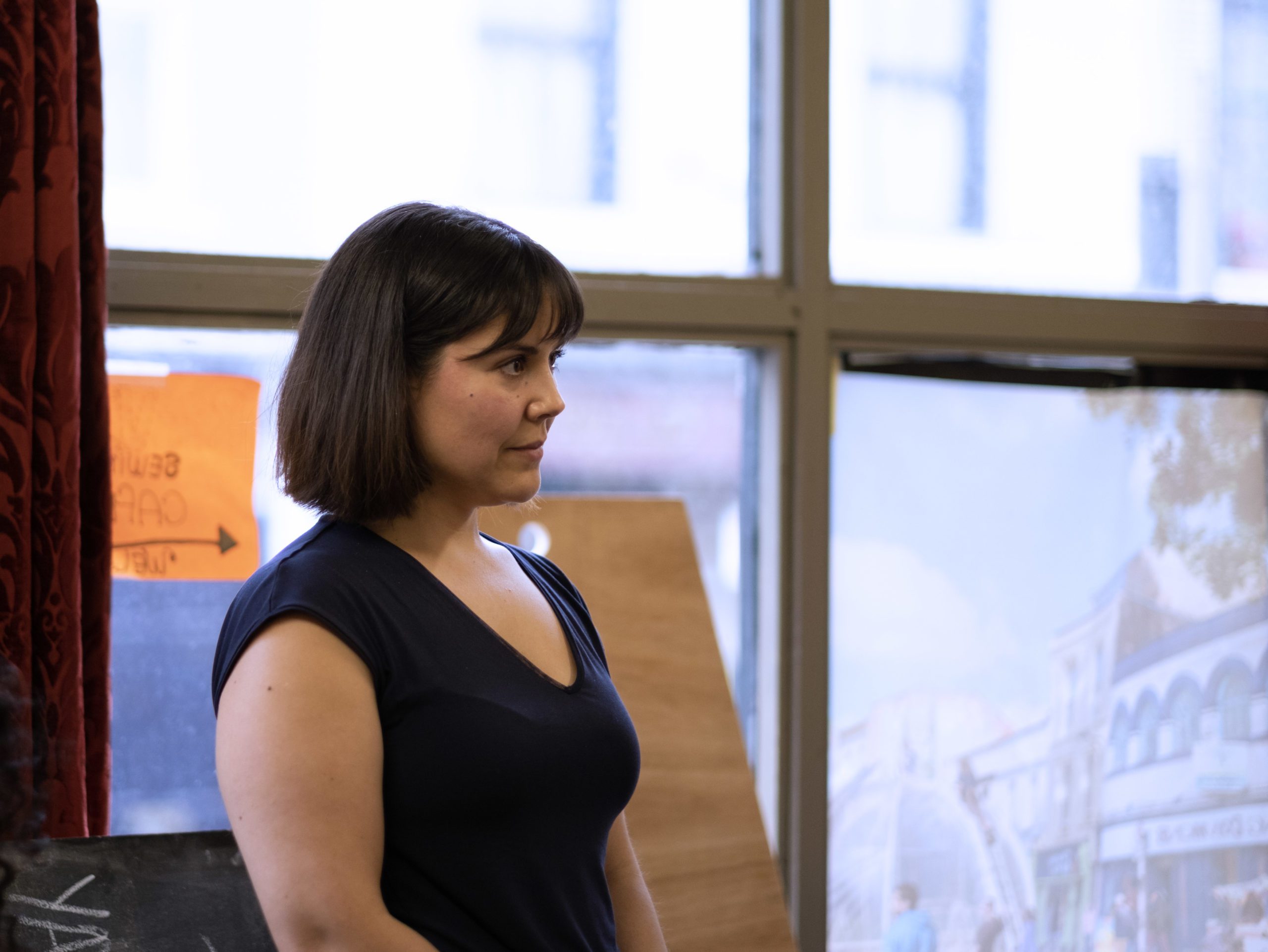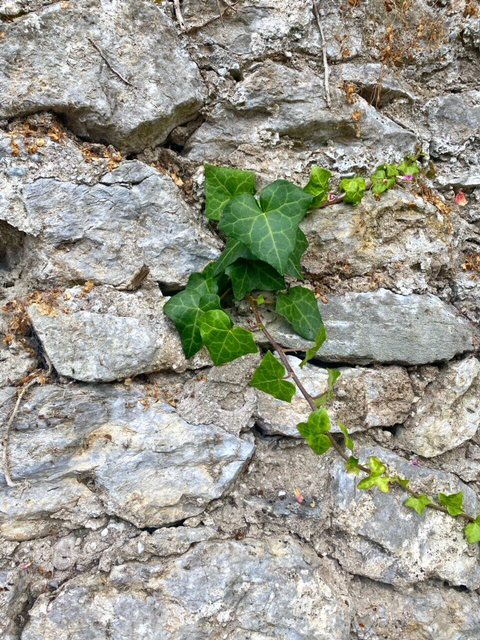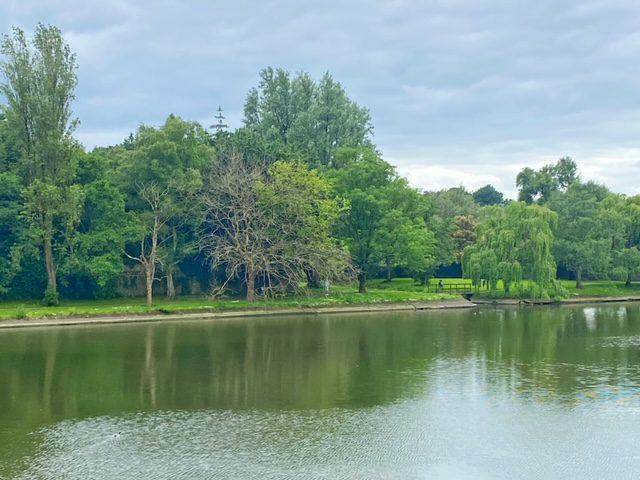Un lugar te lleva a otro
Pilar Miramontes Villarreal

Es un túnel azul claro y verde que parece una entrada a otro lugar, donde ves fragmentos del cielo en los espacios donde las hojas no se tocan. De pronto, da la impresión de que están ahí suspendidas como por acto de magia, como si las ramas no existieran. Te recuerda a un confeti a punto de soltarse para luego flotar en el aire, resistiendo el mayor tiempo posible, antes de tocar el suelo.
El suelo está hecho del típico pavimento que ves en la ciudades, y aunque se antojaría más que fuera un camino de tierra, andar despreocupado por en medio de lo que parece fue una calle (con banquetas y todo) sin estar anticipando que de un momento a otro se aparezca un carro, te empodera. Te hace sentir que le ganaste una pequeña batalla al mundo motorizado, como aquel que apenas puedes ver al otro lado del Río Lee. A mi hermana Montse le encantaría este lugar.
Lo ves un buen rato y sabes que, indudablemente, sus hojas que se dejan caer sin modestia alguna, crean el efecto dramático/romántico que te transporta a otros tiempos y a otro lugar… a mí, a México 1994.
Entre el río y el pavimento hay un jardín lineal que se extiende a lo largo del camino. Es plano hasta cierto punto y luego tiene un desnivel; una bajada que se hace más pronunciada según se acerca al agua. La parte plana está podada, alfombra verde limón que le va bien al verano. Verla te genera un impulso de tirarte un rato a tomar el sol, pero si no caes en la tentación, notarás que también tiene unos puntos blancos extendidos al azar. Ya de cerca, descubres que son adorables margaritas diminutas con pétalos perfectos, y pistilos y estambres amarillos. Son tan chiquitas que es imposible no anticipar que algún paseante distraído las va a aplastar con sus enormes pies. En este momento, la única solución imaginable es quedarte aquí a protegerlas, para siempre.
La parte no podada del jardín también tiene su encanto. El pasto, concedido a seguir su proceso natural floreció, y a cada uno de sus tallos le creció una punta en forma de espiga color arena. Cuando el viento pasa y se mueven de lado a lado, traen a la memoria el público de un concierto con los brazos al aire, moviéndose al ritmo de una canción que casi puedes escuchar; los tallos son los brazos, y las flores, un poco más anchas, son las manos.
Escuchas claramente una mezcla de silbidos. Parece música ambiental, como si hubiera una bocina sobre un tronco, camuflada entre las hojas. Esa sensación, que dura milisegundos, te hace detenerte a reflexionar y caer en cuenta de que a tu alrededor hay un montón de pájaros.Y es que es tan normal y natural escucharlos cuando no los vemos, y verlos cuando no están cantando que es muy fácil olvidarnos de darles crédito. Entonces, al tiempo que dices gracias pajaritos invisibles, cierras los ojos, sueltas el cuerpo y te relajas. Porque miles de años de evolución nos enseñaron que mientras ellos canten, no hay peligro a la redonda.
En este momento, la única solución imaginable es quedarte aquí a protegerlas, para siempre.
En un giro algo amargo, te cruza por la mente que tal vez Cork no es el hábitat natural de algunos pájaros, quizás volaron aquí buscando un lugar menos cálido. Y aunque a veces parece inútil, en medio de la desesperanza encuentras la motivación de seguir tomando acciones que ayuden a disminuir el calentamiento global, porque vale la pena.
La corriente mueve el agua y el agua avanza contigo, al mismo ritmo hacia el este. La primera capa que ilumina como brillantina al reflejar el sol, te hace levantar los pómulos y entrecerrar los ojos cuando la vez directamente, incómodo, pero igual la observas. Y así, te das cuenta de que a simple vista no puedes saber si, en esta parte del puerto, el agua es dulce o salada… o si tal vez sea este el estuario del Río Lee y están ambas mezclándose frente a tus ojos. De los cinco sentidos, el único que realmente podría aclarar esta duda es el gusto, pero estamos de acuerdo que de esta agua no vamos a beber.
Avanzas y al otro lado del camino te encuentras con La Laguna Atlántica, y lo ignoras todo. Los patos pintando estelas, el jardín que rodea el agua, el puente de madera y los demás árboles, excepto uno. Y es que en la orilla, como un recuerdo que puedes ver pero no tocar, hay un Sauce Llorón. Lo ves un buen rato y sabes que, indudablemente, sus hojas que se dejan caer sin modestia alguna, crean el efecto dramático/romántico que te transporta a otros tiempos y a otro lugar… a mí, a México 1994.
Ya de cerca, descubres que son adorables margaritas diminutas con pétalos perfectos, y pistilos y estambres amarillos. Son tan chiquitas que es imposible no anticipar que algún paseante distraído las va a aplastar con sus enormes pies.
Un poco más adelante, al pasar la laguna, se aparece un mar de hojas verdes que parecen decididas a cubrir todo lo que se cruce en su camino. A paso lento, pero convincente, han tapado hasta los árboles. Echándole un poco de imaginación, verás que se ha creado una escena desmedida que simula un conjunto de olas gigantescas en medio del océano, chocando y salpicando en todas las direcciones posibles; caótico y estático a la vez. En medio de ”las olas” hay un castor gigante que parece estar de mal humor. Tal vez nada de esto hace sentido, lo sé.
Al final del camino se abre una explanada de piedra, un espacio peatonal donde hay flores y veleros, todo muy pintoresco. Ves una mini bahía artificial, semicírculo perfecto. Tiene escalones donde la gente se sienta frente al agua, probablemente sin saber o preguntarse si es dulce o salada. Atraviesas y tomas dirección hacia la izquierda para empezar la parte final del recorrido. La calle está enmarcada por dos bardas de piedra, como un corredor que te lleva hasta el castillo. Andando por ahí, notas algo que has visto muchas otras veces, pero te sigue asombrando cada vez que te lo encuentras. En contra de todo pronóstico (considerando lo difícil que a veces puede ser) en la pared han crecido plantas y flores. ¿Cómo? Solo Dios sabe.
Sonríes, porque te recuerda lo que no hace mucho dijo Barry: “a pesar de todo lo que sucede y los problemas que tenemos, al final, la vida sigue… creciendo”.
A place will take you to another
by Pillar Miramontes Villarreal
It is a tunnel, light blue and green, that looks like an entrance to another place, where you see fragments of the sky within the spaces where the leaves don’t reach each other. Suddenly, it seems like they’re suspended with a magic trick, as if the branches didn’t exist. It reminds you of confetti about to be released to then float in the air, for as long as possible, before touching the ground.
The ground is made of the typical pavement you see in cities, and while a road of earth would be more desirable, walking carefree in the middle of what seems to be a street (with sidewalks and everything) without having to anticipate that a car may appear, it empowers you. It makes you feel like you won a little battle against the motorised world. The one you can barely see across the River Lee. Montse, my sister, would love this place.
Throwing a little imagination, you will see that an excessive scene has been created that simulates a set of gigantic waves, in the middle of the ocean, colliding and splashing in all possible directions; chaotic and static at the same time.
Between the river and the pavement, there is a linear garden that extends along the path. It’s flat up to a certain point and then it’s uneven; a slop that becomes more pronounced as it approaches the water. The flat part is trimmed, a lime green rug that suits the summer. Seeing it gives you an urge to lay for a while and sunbathe. If you aren’t giving in to temptation, you notice it also has small white dots, randomly spread. Up close, you discover they are adorable tiny daisies with perfect petals and yellow pistils and stamens. They are so small, it’s impossible not to anticipate that some distracted walker will crush them with their huge feet. Right now, the only solution imaginable is to stay here and protect them, forever.
The unpruned part of the garden also has its charm. The grass, allowed to follow its natural process, bloomed, and each of its stems grew a flower in the shape of a sand colour wheat. When the wind flows and they move from side to side, it brings to memory the crowd in a concert with their arms up in the air, moving to the rhythm of a song you can almost hear; the stems are the arms, and the slightly wider flowers are the hands.
Very clearly, you can hear a mix of whistles. It sounds like background music, like if there was a speaker on a branch, camouflaged among the leaves. That sensation, which lasts milliseconds, makes you stop to reflect and realise that around you, there are a lot of birds. The thing is that, it’s so normal and natural to listen to them when we do not see them, and to see them when they’re not singing, that we easily forget to give them credit. So, as you say “thank you” to invisible birdies, you close your eyes, shake your body and relax. Because thousands of years of evolution taught us that as long as they sing, there is no danger around.
It reminds you of confetti about to be released to then float in the air, for as long as possible, before touching the ground.
In a somewhat bitter twist, it occurs to you that perhaps, Cork is not the natural habitat of some of these birds, perhaps they flew here looking for a cooler place. But in the midst of despair, you grow motivation to keep working against global warming, because it’s worth it.
The current moves the water and the water moves with you, at the same pace, towards the east. The first layer that shines like glitter when it reflects the sun, makes you raise your cheekbones and lower your eyelids when you look at it directly, uncomfortable, but you still stare. And so, you realise that by simply looking you cannot tell if in this part of the harbour the water is fresh or saline… or if maybe this is the estuary of the River Lee and both are mixing in front of your eyes. From our five senses, the only one that could really remove any doubt is the taste, but we can all agree that no one should be drinking this water.
Walking along, on the other side of the road, comes across The Atlantic Pond and you ignore everything. The ducks painting steles, the garden surrounding the water, the wooden bridge, and most of the trees, except one. There, on the shore, like a memory that you can see but cannot touch, there is a Weeping Willow. You stare for a while and conclude that, undoubtedly, the leaves falling unapologetically, add the dramatic/romantic effect that transports you to another place and another time… For me, Mexico 1994.
A little further on, passing the pond, a sea of green leaves emerges determined to cover everything crossing their path. Slowly but convincingly, they have covered even the trees. Throwing a little imagination, you will see that an excessive scene has been created that simulates a set of gigantic waves, in the middle of the ocean, colliding and splashing in all possible directions; chaotic and static at the same time. In the middle of “the waves” there is a giant beaver that seems to be in a bad mood. Maybe none of this makes sense, I know.
You stare for a while and conclude that, undoubtedly, the leaves falling unapologetically, add the dramatic/romantic effect that transports you to another place and another time… For me, Mexico 1994.
At the end of the path lies a stone esplanade, a pedestrian space where there are flowers and sails, all very picturesque. You come across a man-made mini bay, perfect semicircle. It has steps where people sit facing the water, perhaps not knowing, not even wondering, if it is fresh or saline. You overpass it and take a left to start the final part of the journey. The street is framed by two stone walls, like a corridor that leads to the castle. Walking by, you notice something you’ve seen many other times, but continues to amaze you every time you come across it. Against all odds (considering how difficult it can be sometimes) plants and flowers have grown on the stone wall; How? God only knows.
It makes you smile because it reminds you of what, not long ago, Barry said: ‘despite everything that happens and the problems we have, in the end… life grows on’.
Pilar Miramontes Villarreal, or Pili for short, was born and raised in Guadalajara, Mexico. She is the youngest child, which means she will always and forever be the entertainer of the family.
She had a keen interest in art and music as a child and went on to study a degree in multi-disciplinary design. This led to her doing a semester in Santiago, Chile to learn more about textile design. There, she developed a passion for learning about new cultures and embracing different ways of life.
She has been fortunate enough to have lived in Mexico, Chile, Vancouver, Hamburg, Bristol and Cork, each one holding a special place in her heart and all of them influencing who she is today.
She developed an interest in writing while conducting an ethnography during her masters degree in Bristol, and now while living in Cork has found the inspiration to start writing.
Pili likes to write about the recollection of memories in our everyday life. She feels this is ever more important day by day as the world changes, sometimes for the worse – making us take pause and consider what we are losing. Pili is a strong believer in the power of social change and believes that art and literature can influence behaviour. But this doesn’t mean it’s all doom and gloom – as a Mexican she has the ability to find humour in tragedy, and write about it.
No related posts.







